patterns >  The Knit Purl Girl (website) and 1 more...
The Knit Purl Girl (website) and 1 more...
> Orla Sweater

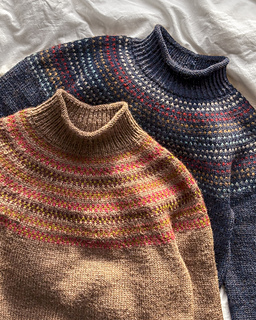
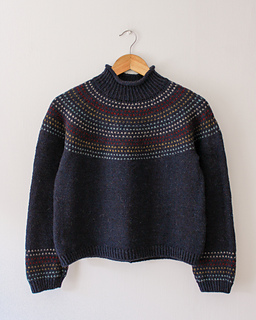
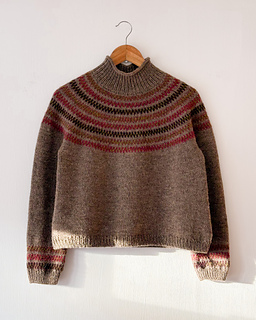
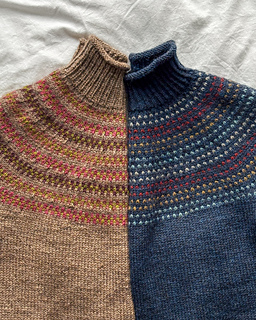
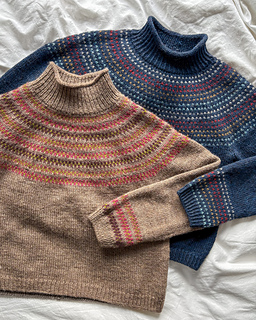


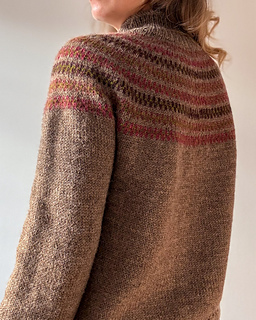
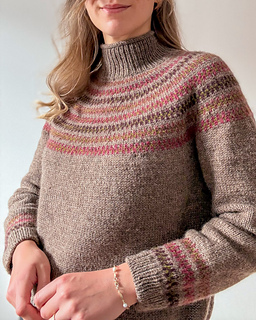

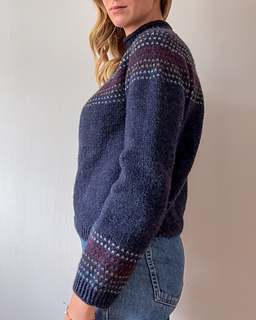
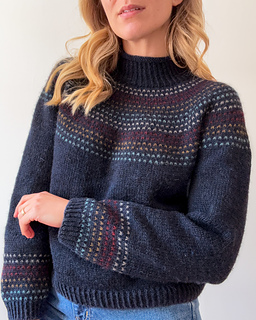
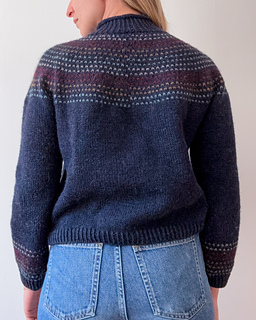
Orla Sweater
Enjoy 25% off all patterns until Monday 1 December 2025, no code needed. Thank you! :)
The Orla Sweater is worked top-down and in the round. You will begin by working the collar, which has a rolled edge and can be worked in either 1x1 rib or half-twisted 1x1 rib to suit your preferences. You will then move onto the circular yoke, which has 2 versions of a stranded colourwork motif. The yoke is finished with German short rows and raglan increases for an improved fit. When the yoke is complete, you will work the length of the body in Stockinette stitch and finish it with 1x1 rib or half-twisted 1x1 rib. Finally, you will work the sleeves which are finished with an optional colourwork motif to match the yoke.
Very excitingly, John Arbon Textiles are offering a 10% discount on their worsted weight yarns, if you fancied making yourself an Orla with their yarn (which I do heartily recommend), and they’ve also made some kits in Harvest Hues Worsted! The discount information is:
OrlaLove will give 10% off their Worsted weight yarns and the Orla Sweater Kit. The code will become active on Nov 28 at 1am, and stays active for 2 weeks, i.e. until Dec 12, 11.59pm.
The kits are available here: https://www.jarbon.com/products/orla-sweater-kit
Materials and Fit
Notions: 4.5 mm / US 7 circular needles with 40-, 60-, and 80-cm / 16-, 24-, and 32-in cords; 3.5 mm / US 4 circular needles with 40- and 60- or 80-cm / 16- and 24- or 32-in cords. If you’re making one of the larger sizes, you may also find it helpful to have both needles with a 100-cm / 40-in cord.
When knitting colourwork, many knitters find that their tension gets tighter. If this is the case for you, you may find it helpful to have a set of 5 mm / US 8 circular needles with 40-, 60-, 80-cm, and/or 100-cm / 16-, 24-, 32-, and/or 40-in cords to correct your tension. I didn’t find this to be particularly necessary for this project since the colourwork is so simple, but it’s worth swatching to check.
You will also need at least 9 ring stitch markers (one of which should be in a contrast colour), your preferred stitch holder (i.e., scrap yarn, a set of spare needles, or a cord), a darning needle, and you may find some clip-on markers helpful to track your work.
Tension: 20 stitches x 26 rounds = 10 x 10 cm / 4 x 4 in in Stockinette stitch on 4.5 mm / US 7 needles.
Sizing and ease: The Orla Sweater has a recommended positive ease of 15-20 cm / 6–8 in for Sizes A-H, and 10-20 cm / 4-8 in for Sizes I-L. However, if you wanted less ease, you would be welcome to choose a smaller size relative to your chest measurement and vice versa.
Size: A (B) C (D), E (F) G (H), I (J) K (L)
Chest measurement (cm): 75-80 (80-85) 85-90 (90-95), 95-100 (100-105) 105-110 (110-115), 115-125 (125-135) 135-145 (145-155)
Chest measurement (in): 29.5-31.5 (31.5-33.5) 33.5-35.5 (35.5-37.5), 37.5-39.25 (39.25-41.25) 41.25-43.25 (43.25-45.25), 45.25-49.25 (49.25-53.25) 53.25-57 (57-61)
Actual circumference of garment at chest (cm): 95 (99) 105 (109), 115 (119) 125 (129), 135 (145) 153 (163)
Actual circumference of garment at chest (in): 37.5 (39) 41.25 (43), 45.25 (46.75) 49.25 (50.75), 53.25 (57) 60.25 (64.25)
Yoke depth (cm): 23 (23.5) 24 (24), 25 (25) 26 (26), 26.5 (27) 28 (29)
Yoke depth (in): 9 (9.25) 9.5 (9.5), 9.75 (9.75) 10.25 (10.25), 10.5 (10.5) 11 (11.25)
Body length from bottom of collar to cast-off at centre back (cm): 52 (52.5) 53 (53), 54 (54) 55 (55), 55.5 (56) 57 (58)
Body length from bottom of collar to cast-off at centre back (in): 20.5 (20.75) 21 (21), 21.25 (21.25) 21.75 (21.75), 22 (22.25) 22.5 (23)
Sleeve circumference at bicep (cm): 31 (32) 34 (35), 36 (37) 39 (40), 41 (45) 49 (53)
Sleeve circumference at bicep (in): 12.25 (12.5) 13.5 (13.75), 14.25 (14.5) 15.25 (15.75), 16.25 (17.75) 19.25 (20.75)
Sleeve length (cm): 43
Sleeve length (in): 17
Yarn: For Sample 1, I used John Arbon Textiles Harvest Hues Worsted (33% Bluefaced Leicester, 33% Falklands Merino, 33% Zwartbles; 100 g = 200 m 219 yds) in the shades Blackthorn (main colour; a deep navy blue), Silver Birch (contrast colour 1; a light grey), Pomegranate (contrast colour 2; a dark red), Flax (contrast colour 3; a golden brown-ochre), and Raindrop (contrast colour 4; a light grey-blue). This sample shows Option 1 for the colourwork motif, and has colourwork in the yoke and the cuffs.
For Sample 2, I used Harvest Hues Worsted again, in the shades Barley (main colour; a saturated taupe), Rosebay (contrast colour 1; a muted dark pink), Burdock (contrast colour 2; a spring green), Loganberry (contrast colour 3; a bright pink), and Elder (contrast colour 4; a dark plum purple). This sample shows Option 2 for the colourwork motif, and also has colourwork in the yoke and cuffs.
You have a lot of flexibility with the number of contrast colours needed for this pattern. You could use 1 main colour and 1 contrast colour, or use a different contrast colour with each motif repeat, which could be up-to 12 contrast colours. For each of my samples, I used 4 contrast colours and the charts have been made with this in mind.
If you are working Option 1 for the charts: In John Arbon Textiles Harvest Hues Worsted, this works out to be 5 (5) 5-6 (6), 6 (6) 6 (6-7), 7 (7) 7-8 (8) 100 g full-sized hanks of your main colour and 1 (1) 1 (1), 1 (1) 1 (1), 1 (1) 1-2 (1-2) 25 g mini hank(s) of each contrast colour.
Note: Sizes K-L will require 2 x 25 g mini hanks of contrast colour 1 and 1 x 25 g mini hank of contrast colours 2-4.
If you want to use a different yarn, I estimate that you will need approximately 920 (980) 1020 (1040), 1120 (1140) 1180 (1240), 1280 (1380) 1430 (1550) m / 1010 (1080) 1120 (1140), 1230 (1250) 1300 (1360), 1400 (1510) 1570 (1700) yds of your main colour and 30 (30) 30 (30), 40 (40) 40 (40), 40 (40) 40-60 (40-60) m 30 (40) 40 (40), 50 (50) 50 (50), 50 (50) 50-70 (50-70) yds of each contrast colour (assuming you are using 4 contrast colours).
Note: Sizes K-L will require 60 m / 70 yds of contrast colour 1 and 40 m / 50 yds of contrast colours 2-4.
If you are working Option 2 for the charts: In John Arbon Textiles Harvest Hues Worsted, this works out to be 5 (5) 5 (6), 6 (6) 6 (6-7), 7 (7) 7-8 (8) 100 g full-sized hanks of your main colour, 1 (1) 1 (1), 1 (1) 1 (1), 1 (1) 1 (1-2) 25 g mini hanks of contrast colours 1, 3, and 4, and all sizes will need 2 25 g mini hanks of contrast colour 2.
If you want to use a different yarn, I estimate that you will need approximately 920 (980) 1000 (1040), 1120 (1140) 1180 (1240), 1280 (1380) 1430 (1550) m / 1010 (1080) 1120 (1140), 1230 (1250) 1300 (1360), 1400 (1510) 1570 (1700) yds of your main colour; 30 (40) 40 (40), 40 (40) 40 (40), 40 (40-50) 40-50 (50) m / 40 (40) 40 (40), 40 (40) 40 (40-50), 40-50 (40-50) 40-50 (50) yds of contrast colours 1 and 3; 50 (50) 50 (50), 50 (50) 60 (60), 60 (60) 60 (70) m / 50 (60) 60 (60), 60 (60) 60 (60-70), 60-70 (70) 70 (70) yds of contrast colour 2; and 30 (30) 30 (30), 30 (30) 30 (30), 30 (30-40) 30-40 (40) m / 30 (30) 30 (30), 30-40 (30-40) 30-40 (30-40), 30-40 (40) 40 (40) yds of contrast colour 4.
345 projects
stashed
308 times
- First published: November 2025
- Page created: Today
- Last updated: Today …
- visits in the last 24 hours
- visitors right now




